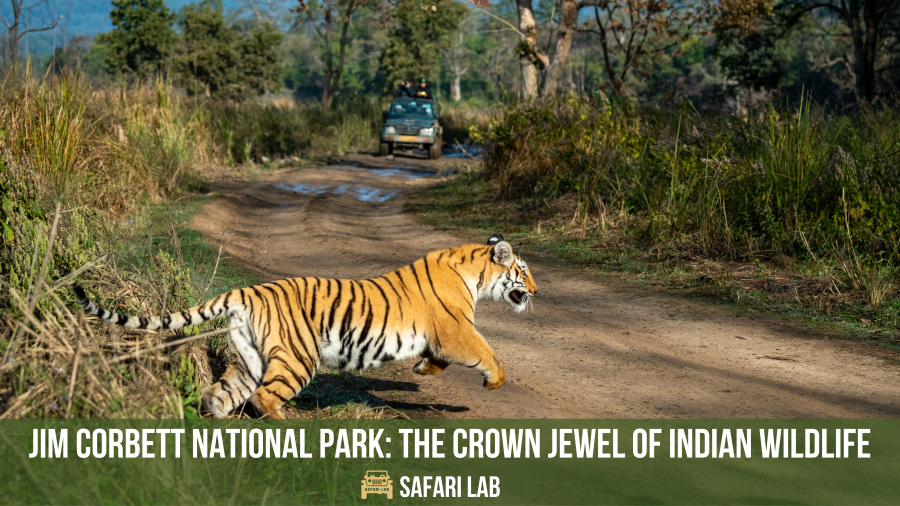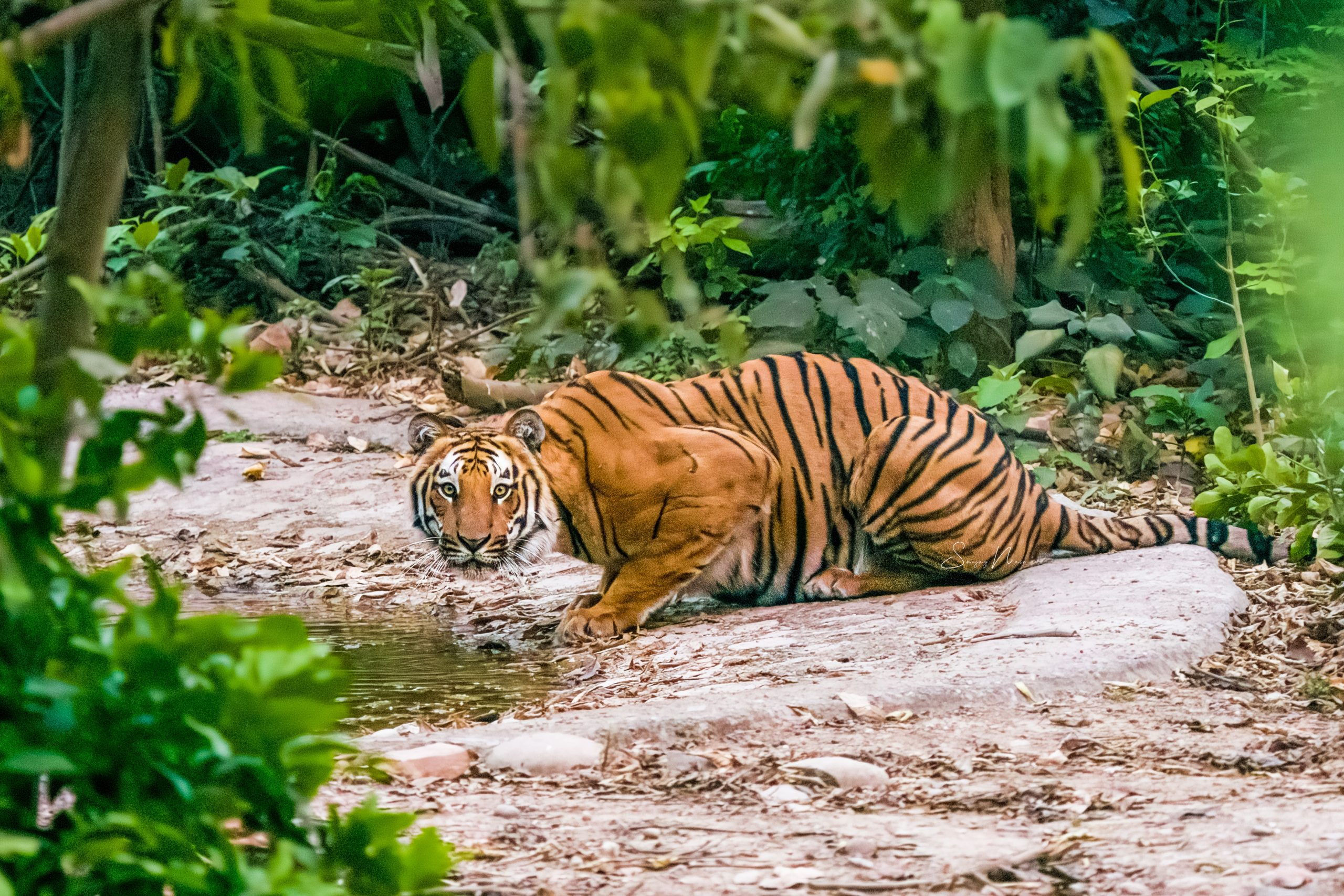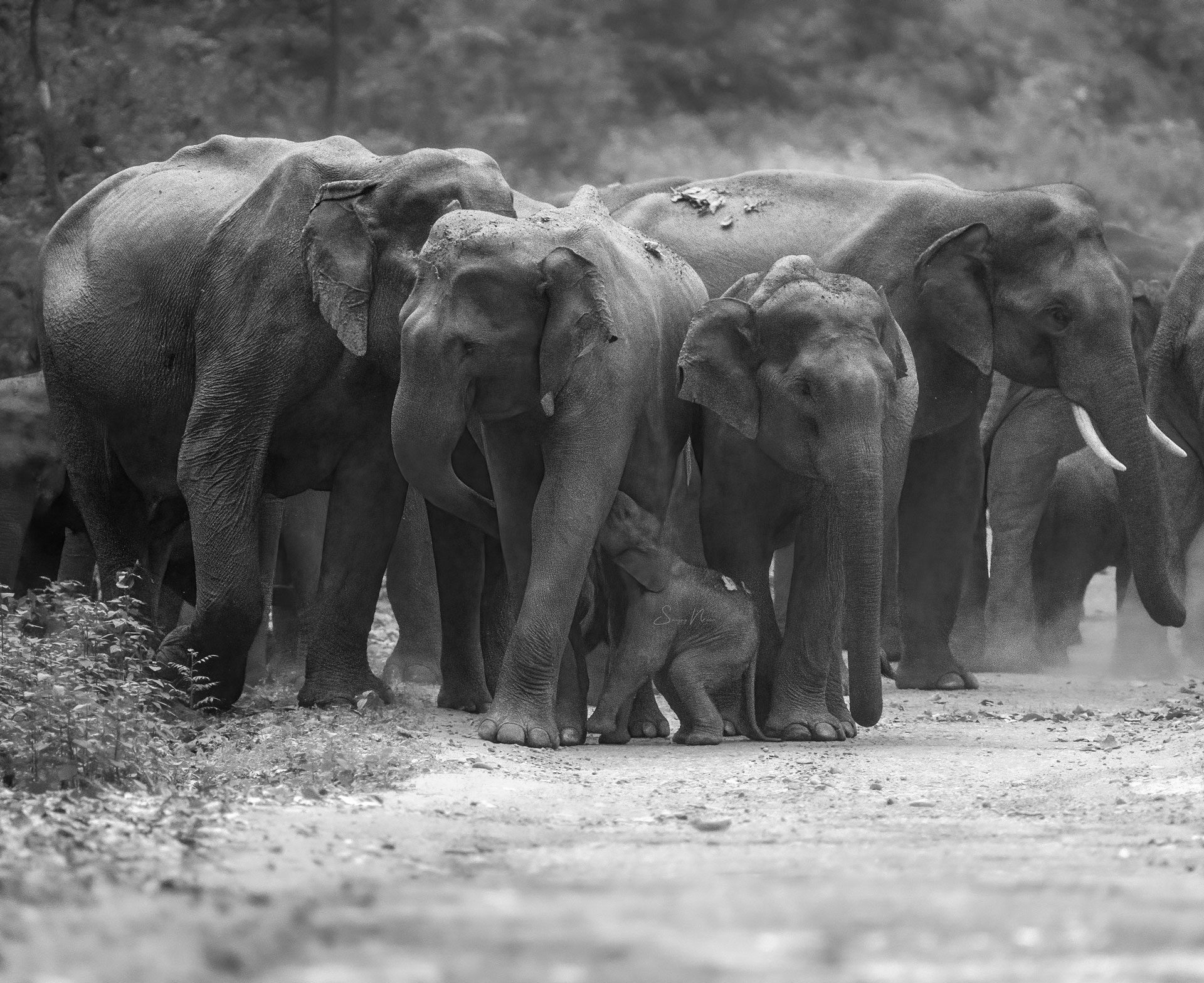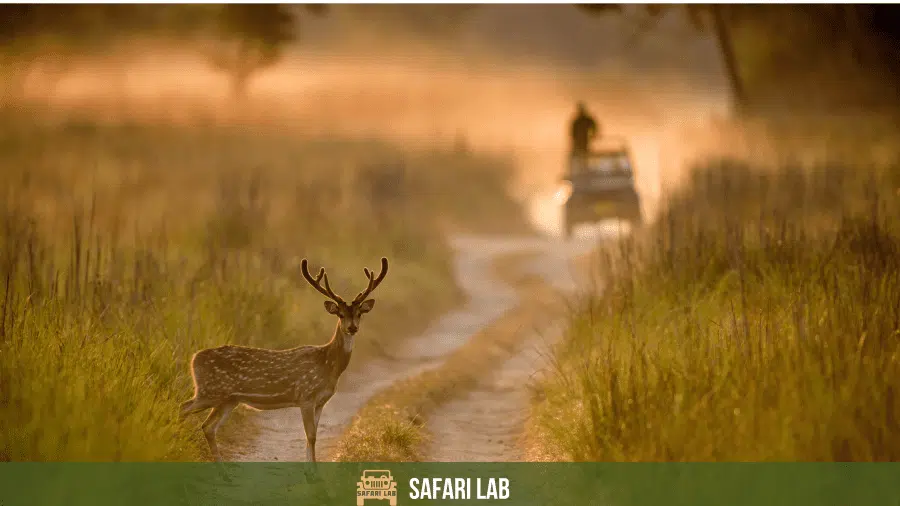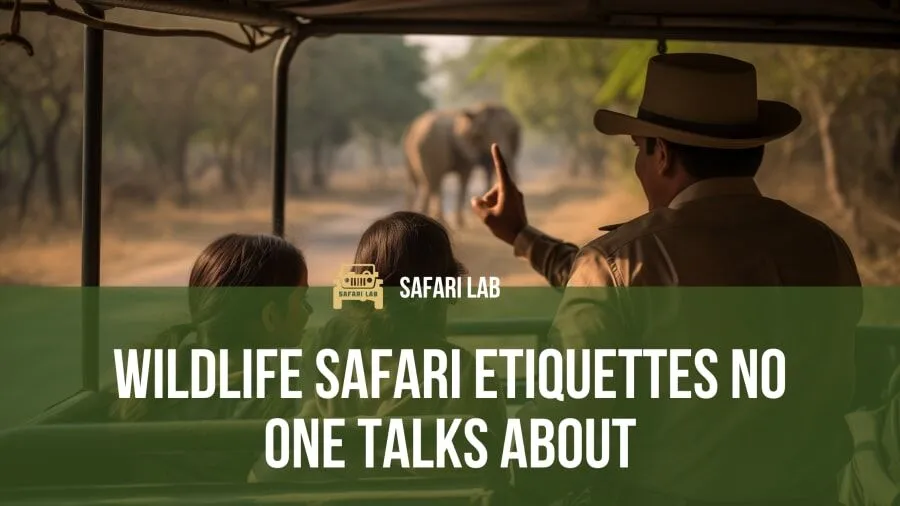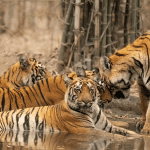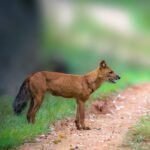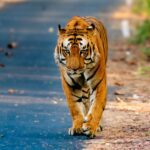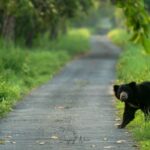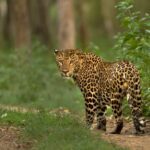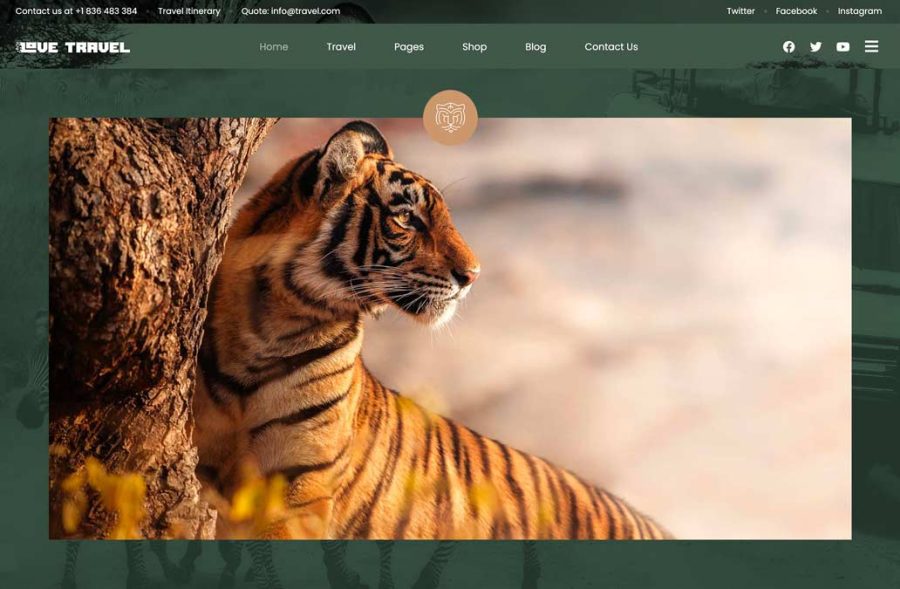Welcome to Jim Corbett National Park, a wildlife sanctuary and tiger reserve located in the beautiful state of Uttarakhand, India. With its breathtaking landscapes, diverse wildlife, and rich biodiversity, this park is truly a crown jewel of Indian wildlife. Whether you’re a nature lover, a wildlife enthusiast, or simply seeking an unforgettable adventure, Jim Corbett National Park is the perfect destination for you.
Established in 1936 and named after the legendary hunter-turned-conservationist, Jim Corbett, this national park spans an impressive 520 square kilometers. It is not only a tiger reserve but also a biodiversity hotspot, showcasing the wonders of nature through its varied ecosystems.
Jump To
ToggleKey Takeaways:
- Jim Corbett National Park is a renowned wildlife sanctuary and tiger reserve.
- It is located in Uttarakhand, India, and spans 520 square kilometers.
- The park offers diverse landscapes, rich biodiversity, and incredible wildlife sightings.
- Established in 1936, it is named after the famous conservationist Jim Corbett.
- Jim Corbett National Park is a must-visit destination for nature enthusiasts and wildlife lovers.
Introducing Jim Corbett National Park
Jim Corbett National Park, established in 1936, holds the prestigious title of being India’s oldest national park. Spanning a vast area, this iconic park boasts diverse ecosystems that are home to a rich variety of flora and fauna. It stands as a true testament to India’s commitment to wildlife conservation and is a paradise for nature enthusiasts and wildlife lovers alike.
The park’s history dates back to the colonial era when it was initially established as Hailey National Park. However, in 1957, it was renamed in honor of Jim Corbett, a legendary hunter-turned-conservationist who played a pivotal role in the park’s foundation and preservation efforts. Located in Uttarakhand, India, Jim Corbett National Park draws visitors from all over the world who seek to witness its mesmerizing natural wonders.
With its diverse range of ecosystems, including dense forests, grasslands, rivers, and marshes, Jim Corbett National Park offers a haven for a wide array of plant and animal species. As one explores the park’s lush landscapes, they can witness the captivating beauty of over 600 species of birds, as well as numerous mammals, reptiles, and amphibians that call this park their home. From the majestic Royal Bengal Tigers to the elusive leopards, the park’s wildlife population is truly a sight to behold.
Flora and Fauna of Jim Corbett National Park
The park’s flora is characterized by its rich diversity, encompassing a multitude of plant species. The vast expanse of the park is covered with a mix of grasslands, sal forests, and riverine vegetation that create a lush and vibrant environment. Visitors can immerse themselves in the tranquil beauty of Jim Corbett National Park as they venture through its pristine landscapes.
When it comes to fauna, the park boasts an incredible collection of wildlife. Apart from the tigers and leopards, visitors might encounter elephants, deer species like sambar and chital, Indian langurs, and mugger crocodiles. The park’s avian residents include the Great Hornbill, Jungle Owlet, and the rare Tawny Fish Owl, making it a paradise for birdwatchers.
Jim Corbett National Park is not just a destination; it’s an immersive experience that allows visitors to connect with nature and witness the wonders of the wild. As you explore the park’s diverse ecosystems, you’ll encounter a tapestry of vibrant landscapes and fascinating wildlife encounters that will leave you in awe.
In the next section, we delve into the crown jewel of Jim Corbett National Park: the Dhikala Zone. Join us as we explore the abundant wildlife and breathtaking landscapes that make this zone a true haven for wildlife enthusiasts.
The Dhikala Zone: A Wildlife Lover’s Paradise
The Dhikala Zone, located in Jim Corbett National Park, is often considered the crown jewel of this magnificent wildlife sanctuary. Offering unparalleled wildlife experiences, this zone is a must-visit for nature enthusiasts and wildlife lovers alike.
The Dhikala Zone is characterized by its dense forests, expansive grasslands, and breathtaking landscapes. It provides visitors with the perfect setting to immerse themselves in the wonders of the natural world. The diversity of habitats in this zone creates an ideal environment for numerous species of wildlife to thrive.
In the Dhikala Zone, you have the opportunity to encounter some of the most majestic creatures on the planet. From the regal tigers to the elusive leopards, this zone offers a chance to witness these magnificent predators in their natural habitats. The thrill of spotting these iconic creatures against the backdrop of the Dhikala Zone’s picturesque landscapes is an unforgettable experience.
Whether you choose to explore the Dhikala Zone on foot or embark on a thrilling safari adventure, the wildlife encounters in this zone are truly awe-inspiring. As you traverse through the forests and grasslands, you will be amazed by the rich biodiversity that inhabits this area. Keep your eyes peeled for exotic birds, graceful deer, playful monkeys, and many other fascinating species that call this zone home.
Visiting the Dhikala Zone in Jim Corbett National Park promises an immersive and unforgettable wildlife experience. It allows you to connect with nature in a profound way and witness the raw beauty and untamed wilderness that makes this zone a true paradise for wildlife lovers.
| Wildlife Encounters in the Dhikala Zone | Key Species |
|---|---|
| Tiger | Royal Bengal Tiger |
| Leopard | Indian Leopard |
| Deer | Spotted Deer, Sambar Deer |
| Langur | Indian Langur |
| Elephant | Asian Elephant |
| Birds | Various species of birds including Eagles, Owls, and Peafowls |
Exploring the Dhikala Zone
When visiting the Dhikala Zone, there are several ways to explore and appreciate its wildlife and natural beauty. Opting for a guided safari experience allows you to venture deep into the heart of the zone while receiving insightful commentary from knowledgeable guides.
Jeep safaris are a popular choice for those seeking an exciting and convenient way to traverse the Dhikala Zone. These safaris offer the flexibility to cover vast areas and increase the chances of wildlife sightings. Alternatively, elephant safaris provide a unique perspective as these gentle giants gracefully navigate through the wilderness.
Whichever mode of exploration you choose, the Dhikala Zone promises to leave you in awe of its captivating wildlife and stunning landscapes.
“The Dhikala Zone is a wildlife lover’s dream come true. With its diverse habitats and rich biodiversity, it offers an unparalleled opportunity to witness India’s magnificent wildlife up close.” – Wildlife Enthusiast
Safari Adventures in Dhikala
To fully experience the wonders of the Dhikala Zone in Jim Corbett National Park, visitors can embark on thrilling safari adventures. Whether you choose a jeep safari or an elephant safari, these expeditions offer incredible opportunities to encounter the diverse wildlife that calls this region home.
Jeep Safaris:
Jeep safaris are a popular choice for exploring the Dhikala Zone. Hop aboard a sturdy 4×4 vehicle and venture deep into the heart of the wilderness. With experienced guides leading the way, you’ll traverse rugged terrains, passing through dense forests and sprawling grasslands. Keep your eyes peeled for wildlife sightings as you navigate the park’s winding trails.
Both the jeep safari options provide opportunities to encounter a wide range of bird species, from colorful feathered friends to magnificent raptors soaring through the sky. The Dhikala Zone is a birdwatcher’s paradise, offering the chance to capture stunning avian photographs and witness the fascinating behaviors of these winged creatures.
Corbett Park Photography
Here’s some glimpses of Safari Lab’s tours at Jim Corbett Park
Forest Rest House Dhikala: A Serene Retreat
Escape into the tranquil embrace of nature at the Dhikala Forest Rest House, a hidden gem nestled in the heart of Jim Corbett National Park. Surrounded by lush greenery and breathtaking landscapes, this serene retreat offers a peaceful environment that rejuvenates the mind, body, and soul.
As you step into the rest house, you’ll be greeted by the symphony of birdsong, filling the air with their melodious tunes. The low-disturbance setting allows you to immerse yourself in the peaceful ambiance, away from the hustle and bustle of city life.
The Dhikala Forest Rest House provides a unique opportunity to connect with nature on a deeper level. Whether you’re a wildlife enthusiast, a birdwatcher, or simply seeking solace amidst nature’s beauty, this retreat offers a perfect sanctuary.
“The tranquility of the forest and the beauty of the surroundings make the Dhikala Forest Rest House a true haven for those seeking an escape from the chaos of everyday life.” – Traveler’s Review
With comfortable accommodations, friendly staff, and mesmerizing views from every corner, the rest house ensures a truly memorable experience. Wake up to the gentle embrace of nature, watch the sunrise over the verdant landscape, and indulge in the serenity of your surroundings.
Immerse yourself in the beauty of the Dhikala Forest Rest House and discover the true essence of a nature retreat.
Exploring Different Zones in Jim Corbett National Park
Jim Corbett National Park, located in Uttarakhand, India, is divided into multiple zones, each offering unique habitats and wildlife populations. Exploring these zones allows visitors to discover the distinct characteristics and diverse wildlife found within the park.
Bijrani Zone
The Bijrani Zone is known for its dense forests and grasslands, providing a perfect habitat for a variety of wildlife species. It offers thrilling wildlife sightings, including the majestic Bengal tiger, leopards, elephants, deer, and a wide array of bird species.
Jhirna Zone
The Jhirna Zone is famous for its picturesque landscapes and remarkable biodiversity. It is home to a thriving population of deer, including the spotted deer and sambar deer. Visitors can also spot sloth bears, wild boars, and various bird species in this captivating zone.
Dhela Zone
The Dhela Zone is known for its tranquil ambiance and pristine forests. It provides a serene environment for encountering diverse wildlife, including tigers, elephants, langurs, and numerous bird species. Nature enthusiasts can immerse themselves in the rich biodiversity of this zone.
Garjia Zone
The Garjia Zone is characterized by its picturesque landscapes and the mesmerizing Ramganga River. It offers a unique opportunity to spot wildlife in a riverside setting. Visitors can witness the beauty of crocodiles, deer, elephants, and a wide range of avian species while enjoying the serene river backdrop.
Phato Zone
The Phato Zone is known for its abundance of birdlife, making it a paradise for birdwatching enthusiasts. Here, visitors can observe a diverse range of migratory and resident bird species, including kingfishers, flycatchers, owls, and many more. The zone’s serene environment creates a perfect setting for birdwatching excursions.
| Zone | Key Features | Wildlife Populations |
|---|---|---|
| Bijrani Zone | Dense forests and grasslands | Tigers, leopards, elephants, deer, various bird species |
| Jhirna Zone | Picturesque landscapes and remarkable biodiversity | Deer, sloth bears, wild boars, various bird species |
| Dhela Zone | Tranquil ambiance and pristine forests | Tigers, elephants, langurs, various bird species |
| Garjia Zone | Picturesque landscapes and the mesmerizing Ramganga River | Crocodiles, deer, elephants, wide range of avian species |
| Phato Zone | Abundance of birdlife | Migratory and resident bird species |
Birdwatching in Avian Paradise
If you’re a lover of birds, Jim Corbett National Park is your ultimate destination. Not only is it renowned for its majestic mammals, but it is also a haven for avian diversity. With its varied habitats and favorable climate, the park attracts a wide range of bird species, both migratory and resident.
Embark on birdwatching excursions within the park, and you’ll be rewarded with captivating sights and sounds of vibrant feathered creatures. Witness the breathtaking plumage and mesmerizing melodies as you explore the avian paradise that is Jim Corbett National Park.
Whether you’re an experienced birdwatcher or a novice enthusiast, the park’s diverse birdlife will surely captivate your senses. From soaring raptors to elegant waterfowls and melodious songbirds, there’s something for everyone to marvel at.
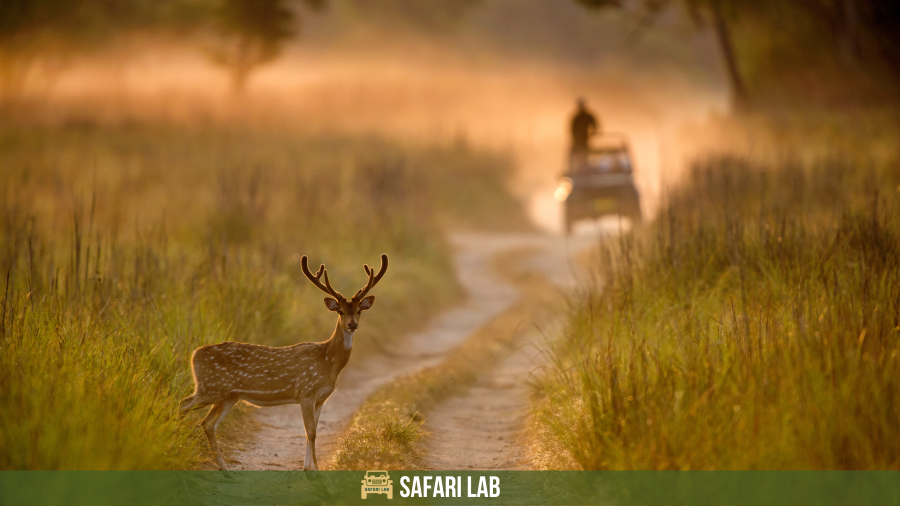
Avian Diversity at Jim Corbett National Park
The park boasts an impressive variety of avian species, making it a mecca for birdwatchers. Its unique combination of diverse habitats, including dense forests, grasslands, and riverbanks, provides a rich feeding and breeding ground for numerous bird species.
While some birds call Jim Corbett National Park their year-round home, others make impressive journeys across continents to spend the winter months or breed in its inviting environs. Migratory birds add an extra dimension to the park’s avian diversity, with their arrival marking the changing seasons.
Here, resident birds and migratory visitors coexist, creating a harmonious blend of different species. From the regal Indian peacock to the elusive Himalayan rubythroat, the park’s avian community never fails to astound.
Must-See Bird Species
To give you a glimpse of the avian wonders awaiting you, here are a few notable bird species you may encounter during your birdwatching expedition in Jim Corbett National Park:
- White-throated Kingfisher
- Indian Paradise Flycatcher
- Crested Serpent Eagle
- Collared Falconet
- Great Hornbill
| Species | Scientific Name | Conservation Status |
|---|---|---|
| White-throated Kingfisher | Halcyon smyrnensis | Least Concern |
| Indian Paradise Flycatcher | Terpsiphone paradisi | Near Threatened |
| Crested Serpent Eagle | Spilornis cheela | Near Threatened |
| Collared Falconet | Microhierax caerulescens | Near Threatened |
| Great Hornbill | Buceros bicornis | Near Threatened |
These are just a few examples of the remarkable bird species that call Jim Corbett National Park home. Exploring the park’s diverse ecosystem will undoubtedly reveal many more hidden avian gems.
“Birds have wings; they’re free; they can fly where they want when they want. They have the kind of mobility many people envy.” -Roger Tory Peterson
So, pack your binoculars, grab a field guide, and get ready to immerse yourself in the fascinating world of birdwatching at Jim Corbett National Park. Witness the intricate beauty of these magnificent creatures, and let their melodies fill your heart with joy.
Conservation Efforts and Responsible Tourism
The awe-inspiring wildlife and natural beauty of Jim Corbett National Park are the result of dedicated conservation efforts. The park authorities work tirelessly to protect and preserve the delicate ecological balance. Visitors are encouraged to practice responsible tourism by following park regulations and respecting the natural habitats of the wildlife, ensuring the sustainability of this remarkable destination.
Preserving the Biodiversity
Conservation efforts in Jim Corbett National Park aim to safeguard the diverse flora and fauna that call this place home. The park acts as a critical habitat for endangered species like Bengal tigers, Asian elephants, and the Himalayan black bear. Through habitat restoration, anti-poaching initiatives, and strict wildlife protection measures, the park authorities strive to maintain the delicate balance of this unique ecosystem.
Community Engagement and Awareness
Responsible tourism goes beyond environmental conservation; it also involves engaging with local communities and raising awareness about wildlife preservation. Jim Corbett National Park works closely with neighboring communities to promote sustainable livelihood opportunities that reduce dependence on natural resources. By supporting local initiatives such as eco-friendly handicrafts and community-driven tourism activities, visitors contribute to the long-term well-being of both the local communities and the park.
“Responsible tourism is an essential component of preserving the natural and cultural heritage of Jim Corbett National Park. By being mindful of our actions and respecting the park’s regulations, we can ensure that future generations can continue to experience the wonders of this remarkable destination.”
Minimizing Environmental Footprint
To minimize the impact on the park’s fragile ecosystem, responsible tourists are encouraged to practice Leave No Trace principles. This includes properly disposing of waste, refraining from picking plants or disturbing wildlife, and sticking to designated trails. By treading lightly and leaving nature undisturbed, visitors play an active role in minimizing their environmental footprint and protecting the natural beauty of Jim Corbett National Park.
Educational and Ethical Wildlife Tourism
Jim Corbett National Park offers a range of wildlife tourism experiences, including jeep safaris and elephant safaris. These activities provide opportunities for visitors to observe and appreciate the park’s diverse wildlife. However, it is crucial to ensure that these activities prioritize the well-being and conservation of the animals. Responsible tourists should choose operators that adhere to ethical practices, prioritize wildlife welfare, and provide educational insights into the importance of wildlife preservation.
By embracing responsible tourism and supporting the conservation efforts of Jim Corbett National Park, visitors can contribute to the long-term sustainability of this natural treasure. Together, we can ensure that future generations can continue to marvel at the remarkable wildlife and pristine landscapes that make this park so special.
Responsible Safari Experiences
When visiting Jim Corbett National Park, a safari experience is a must to fully immerse yourself in the park’s natural wonders. The park offers a variety of safari options that cater to different preferences and wildlife sightings. Two popular choices are the jeep safari and the elephant safari, each providing a unique perspective on the park’s diverse terrain and wildlife.
Jeep Safari
The jeep safari allows you to explore the park’s vast landscapes and navigate through various terrain types, including dense forests, grasslands, and riverbanks. Led by experienced guides, these safaris offer the flexibility to cover a larger area and increase your chances of encountering different wildlife species. From spotting majestic tigers to observing deer, monkeys, and a myriad of bird species, the jeep safari promises an exhilarating adventure.
While enjoying these safari experiences, it is crucial to prioritize the welfare of the wildlife and contribute to their conservation. Here are some tips to ensure responsible safari experiences:
- Follow the instructions of your safari guide and adhere to park regulations at all times.
- Do not disturb or feed the animals, as this can disrupt their natural behavior and ecosystems.
- Respect the personal space of the wildlife by maintaining a safe distance and using binoculars or zoom lenses for closer observation.
- Refrain from littering and help keep the park clean to protect the environment and prevent harm to wildlife.
- Support wildlife welfare initiatives and ethical tour operators that prioritize conservation and responsible tourism practices.
Remember, responsible safari experiences not only ensure the well-being of the wildlife but also contribute to the long-term preservation of Jim Corbett National Park’s unique biodiversity.
| Responsible Safari Experiences Checklist |
|---|
| Follow park regulations and safari guide instructions |
| Avoid disturbing or feeding wildlife |
| Maintain a safe distance and use binoculars for closer observation |
| Dispose of waste properly and keep the park clean |
| Support ethical tour operators and wildlife welfare initiatives |
By adopting these responsible practices, you can fully enjoy your safari experiences while ensuring the wildlife’s welfare and the long-term preservation of Jim Corbett National Park’s remarkable ecosystem.
Embracing the Symphony of Nature’s Delights
Jim Corbett National Park offers more than just wildlife sightings. It is a place where visitors can embrace the symphony of nature’s delights. The park is home to pristine rivers like the Ramganga River and the Kosi River, adding to the serene beauty of the surroundings. These majestic rivers provide a multitude of activities for nature enthusiasts and adventure seekers alike.
One of the highlights of visiting Jim Corbett National Park is the opportunity to relax and unwind by the riverside. The Ramganga River and the Kosi River offer picturesque spots where visitors can enjoy a peaceful picnic amidst nature’s splendor. Immerse yourself in the tranquility of the flowing waters, surrounded by lush greenery and the melodious sounds of wildlife.
| River | Activities |
|---|---|
| Ramganga River | Relaxation, Picnics, Fishing |
| Kosi River | River Rafting, Nature Walks |
For those seeking more adventure, the Kosi River offers exhilarating options. Embark on a thrilling river rafting journey and feel the rush of adrenaline as you navigate the gushing rapids. Take in the breathtaking scenery and let the untamed beauty of the river sweep you away. If you prefer a more leisurely experience, explore the river’s banks on nature walks and discover hidden gems along the way.
The Ramganga River and the Kosi River are not just bodies of water; they are integral parts of the natural ecosystem within Jim Corbett National Park. Their presence enhances the overall beauty of the park, providing a sense of harmony that complements the diverse wildlife and breathtaking landscapes.

Immerse yourself in the untamed beauty of Jim Corbett National Park by embracing the rivers that flow through its heart. Experience nature’s symphony of delights as you relax by the Ramganga River, partake in picnics, fishing, and river rafting on the Kosi River. Let the rivers be your guide, as you discover the wonders that await in this remarkable destination.
Conclusion
Jim Corbett National Park is a true paradise for nature enthusiasts, offering an extraordinary journey into the wild. With its diverse wildlife, including majestic tigers and a rich avian population, the park never fails to amaze visitors with its wildlife wonders. The breathtaking landscapes and pristine rivers add to the charm, showcasing nature’s beauty at its finest.
However, as we explore this remarkable destination, it is crucial to prioritize responsible tourism and conservation efforts. By following park regulations and respecting the natural habitats of the wildlife, we can ensure the preservation of Jim Corbett National Park for future generations to experience and enjoy. Together, let us protect this sanctuary of nature and keep its beauty intact.
Plan your visit to Jim Corbett National Park and embark on an unforgettable adventure that will undoubtedly leave you in awe of the wildlife wonders and nature’s unparalleled beauty that this park has to offer.
FAQ
What is Jim Corbett National Park?
Jim Corbett National Park is a premier wildlife sanctuary and tiger reserve located in Uttarakhand, India. It is a biodiversity hotspot renowned for its rich flora and fauna, making it a popular destination for ecotourism.
When was Jim Corbett National Park established?
Jim Corbett National Park was established in 1936. It is India’s oldest national park and covers a vast area of diverse ecosystems.
What is the Dhikala Zone in Jim Corbett National Park known for?
The Dhikala Zone is considered the crown jewel of Jim Corbett National Park. It offers immersive wildlife experiences with dense forests, grasslands, and picturesque landscapes. Visitors can spot majestic tigers and elusive leopards in their natural habitats, making it a must-visit zone for wildlife lovers.
What types of safaris can I experience in Dhikala Zone?
In Dhikala Zone, visitors can embark on thrilling jeep safaris and elephant safaris. These safari adventures provide unique opportunities to encounter elephant herds, deer, monkeys, and a variety of bird species, allowing you to witness the diverse wildlife up close.
What is the Dhikala Forest Rest House?
Dhikala Forest Rest House is a serene retreat nestled in the heart of Jim Corbett National Park. Surrounded by lush greenery, it provides a peaceful environment for visitors to connect with nature. The rest house offers a low-disturbance setting, allowing guests to experience the harmonious symphony of birdsong.
How many zones are there in Jim Corbett National Park?
Jim Corbett National Park is divided into several zones, including Bijrani, Jhirna, Dhela, Garjia, and Phato. Each zone offers unique habitats and wildlife populations, providing different experiences for visitors.
Is Jim Corbett National Park a good place for birdwatching?
Yes, Jim Corbett National Park is a paradise for bird enthusiasts. The park is home to a wide range of avian species, including migratory birds and resident birds. Birdwatching excursions offer the opportunity to witness the vibrant colors and melodies of the park’s diverse birdlife.
What conservation efforts are undertaken in Jim Corbett National Park?
The authorities of Jim Corbett National Park work tirelessly to protect and preserve the delicate ecological balance of the park. They are dedicated to the conservation of wildlife and the sustainability of the park’s natural habitats.
What types of safari experiences are available in Jim Corbett National Park?
Jim Corbett National Park offers jeep safaris and elephant safaris. These safari options allow visitors to explore the park’s diverse terrain and maximize wildlife sightings. It is important for visitors to prioritize the welfare of the wildlife and preserve the integrity of their natural habitats during these safari experiences.
Are there activities other than wildlife sightings in Jim Corbett National Park?
Yes, Jim Corbett National Park offers more than just wildlife sightings. It is a place where visitors can embrace the symphony of nature’s delights. You can relax, have picnics, go fishing, or even engage in river rafting along pristine rivers like the Ramganga River and the Kosi River, immersing yourself in the untamed beauty of the park.
What makes Jim Corbett National Park a remarkable destination?
Jim Corbett National Park captivates visitors with its awe-inspiring wildlife wonders and the beauty of nature. It is home to majestic tigers, diverse birdlife, and breathtaking landscapes. By embracing responsible tourism and conservation efforts, we can help preserve this remarkable destination for future generations to enjoy.
Recent Posts
Archives
Categories
Customized Trip Form
Author

Sanjay Nair is a multi-award-winning wildlife photographer, conservation storyteller, and co-founder of Safari Lab. With over 15 years of fieldwork and a Nature in Focus award under his belt, Sanjay’s photographs and stories have been published in global outlets such as The Times & The Guardian.
View all posts

